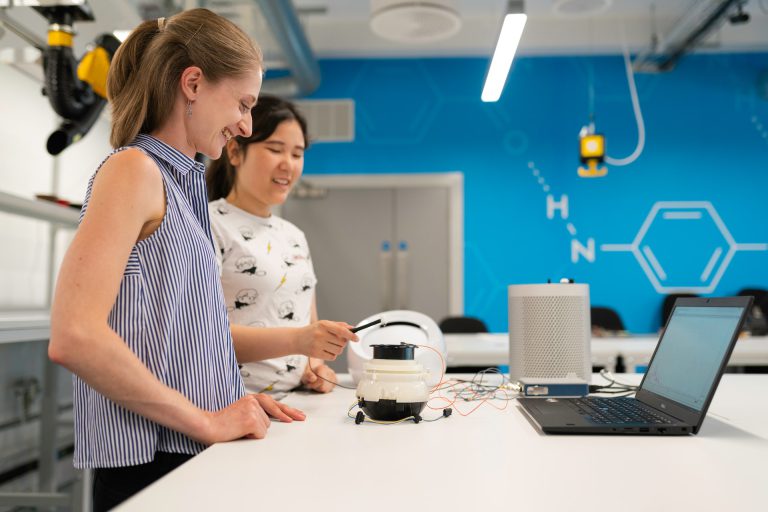The role of STEAM in employability and overcoming the female digital divide
8 March, 2023 Photo by ThisisEngineering RAEng on Unsplash
Photo by ThisisEngineering RAEng on UnsplashProgrammes based on scientific and artistic disciplines are extremely useful for overcoming the digital divide for girls in education and guaranteeing their future employment
What STEAM means
The term STEM was coined by the National Science Foundation, an independent federal agency that supports US science and engineering, to refer to the disciplines of science, technology, engineering and mathematics. Society has had an increasing need to include artistic disciplines and design in recent years. The Rhode Island School of Design responded to this need by contributing to the popularization of STEAM: science, technology, engineering, art and mathematics.
In the field of education, STEAM refers, therefore, to an integrative learning model based on the teaching of these five disciplines. It generally uses methodologies such as reflective learning and project-based learning, which foster the learner’s training process by means of their personal search for answers to the questions or challenges raised in class. Students thereby become proficient in skills such as problem-solving using the scientific method, as well as the use of information and communication technology (ICT). Some academic articles have reported that these methodologies have positive results. For example, in the article “The usage of STEAM program in developing and improving of students’ experimental skills“, the author reports that students “learned to how to plan and perform experiments, acquired the ability to formulate hypotheses, to make assumptions, to analyse and explain results, and to formulate reasoned conclusions” (Šlekienė, 2019).
Some figures to help understand the present and future scenarios
Society reflects every major change associated with digital transformation; the labour market needs people with training in the most cutting-edge disciplines, and professions emerge in the wake of every technological invention. The World Economic Forum’s The Future of Jobs report stresses that the workforce is specializing in ICT-related areas (WEF, 2016).
The most pressing issue in terms of the digital gender divide and the smaller proportion of women in technological or scientific careers is that if specific measures are not taken so that women participate in these areas, their professional, social and economic development could be at risk due to the needs of the ICT-oriented labour market (Juvera and Hernández, 2021), and female unemployment could increase alarmingly in the near future.
The LinkedIn article on “Jobs on the rise in 2023” highlights the 25 most in-demand jobs over the last five years, and the trends that are shaping the future of the labour market. They include new professions related to STEAM, for which the recruitment percentages differ considerably by gender, such as cybersecurity analysts (14% women; 86% men), site reliability engineers (5% women; 95% men), artificial intelligence engineers (15% women; 85% men), and DevOps engineers (10% women; 90% men).
Women have a strong presence in some degree courses in the STEAM fields, but rather than technology they tend to be related to health, where they account for 78% of students in middle-level vocational training and 76% in higher-level vocational training. On university bachelor’s degree courses, the percentage of women is 69% for Medicine, 82% for Nursing and 75% for Biomedicine (Zafra, 2022).
According to the figures in the first report of the STEAM Alliance produced by the Equality Unit of the Spanish Ministry of Education and Vocational Training, in the period between the 2008/2009 and the 2020/2021 academic years, there was an increase of 3.86% in the number of girls taking upper secondary education courses in science and technology (Grañeras et al., 2021). This could be due to increasing social awareness of the importance of women studying these disciplines, in view of the growing trend towards new technological and science-related professions. However, not all the figures are as optimistic. According to the percentages of students enrolled on a university bachelor’s degree courses at public universities by gender and branch of education in the 2020/21 academic year, in the branch of engineering and architecture fewer than a third of the students are women (25.80% compared to 74.20%) (Grañeras et al., 2021).
In Europe as a whole, according to the figures for 2018, among students with high performance levels in mathematics and science who chose STEAM professions, 21.3% of boys chose professions related to science and engineering compared to 11.7% of girls, and the figures were similar for ICT, with 10.1% for boys and 1.2% for girls.
But this has not always been the case. However, we have to hark back to the earliest days of programming in the 1960s and the subsequent decades, when women became programmers and accounted for 37.1% of computer science students in the United States in 1984.
As for the digital gender divide, in the article “A major challenge for e-literacy: the digital gender divide“, we examined a number of figures that highlight the inequalities in terms of ICT ownership and operability. According to UNICEF, 393 million adult women in developing countries do not have mobile phones, which limits their opportunities for digitalization. This problem begins in childhood, as 1.3 billion children between the ages of three and seventeen years old do not have an internet connection at home (UNICEF & ITU, 2020). Taken as a whole, this makes it extremely difficult for girls in particular, for social and cultural reasons, to have regular access to ICT tools, be educated in digital skills and become media literate.
How STEAM can help with the digital gender divide
Gender norms, negative stereotypes, barriers and the digital gender divide continue to prevent girls from achieving their potential (Grañeras et al., 2021). Private and public education institutions and government initiatives have a decisive role to play when undertaking actions to remedy this situation. In the article entitled “How to Address Stereotypes and Practices Limiting Access to STEM-Related Education for Women and Girls“, the researcher Milagros Sáinz, the leader of the GenTIC group at the Universitat Oberta de Catalunya (UOC), examines the reasons for the constraints on female representation, including the reinforcement of stereotypes concerning some professions in the mass media, social networks, advertising, and video games (Sainz, 2022).
Some measures to encourage girls to pursue STEAM disciplines and acquire ICT skills include:
- Providing access to technological equipment and internet connections and training in ICT skills.
- Breaking down gender stereotypes.
- Raising the profile of female role models in scientific and technical careers.
- Making science, technology and ICT more accessible to girls through school curricula based on STEAM subjects, or with extracurricular activities.
- Using the “A” in STEAM to encourage girls to study these disciplines by means of design, art, gamification and multimedia.
- Raising awareness of professions related to digitalization and the opportunities that they offer.
There are currently some very interesting initiatives promoting STEAM among girls, including TecnoGirls on the Mataró TecnoCampus, which is a project that primarily aims to raise awareness of science and technology among secondary school students. It aims to promote technological vocations among girls aged between 12 and 18 years old, in order to contribute to overcoming the gender divide in professions in this area. To that end, they organize activities including a travelling exhibition that visits the libraries of the Maresme region, and an online exhibition about leading female figures in technology, workshops on technology, science and art, and the HackGirl hackathon for girls.
Among the university volunteer programmes in which the UOC participates is Technovation Girls, an initiative led by the Espiral Association, in collaboration with the NGO Technovation. Its aim is to promote digital entrepreneurship and STEAM vocations among girls and teenagers aged between 8 and 18 in Catalonia. The programme forms teams of up to five girls and a mentor who work on a scheduled basis to detect a need in their environment and come up with a solution by designing and programming a mobile application to help solve it.
They are a very good way of fostering equality and friendship between boys and girls so that they learn together and for making STEAM for both genders into activities they do together. The InspiraSTEAM project organized by the University of Deusto is a pioneering initiative which aims to foster scientific and technological vocations among girls, based on awareness and guidance actions. The training sessions are taught by volunteer mentors who are professionals from the research world, and involve mentoring in groups. They train girls and boys in science and technology, promoting STEAM among primary school students.
Other initiatives reinforce the role of creating gamified or multimedia-related experiences. The article entitled “Tech-Savvy Girls: Learning 21st-Century Skills Through STEAM Digital Artmaking” explains how girls on different courses were encouraged to use technology to create and explore different forms of digital artistic creation in activities related to storytelling, personal experience and technological literacy, creating animations and video games. The result was very positive: “the girls learned how to collectively engage in meaningful digital art creation by exploring roles of leadership with 21st-century knowledge and skills, increasing their confidence to pursue future technology-related careers” (Liao et al., 2016). A survey of these female students concluded that “they gain different perspectives and insights on technology, as well as the understanding that women can also make a difference using technology” (Liao et al., 2016).
Conclusions
Immediate action is required in the face of the social problems of limited representation of women in science and tech fields and professions, and the growing need for professionals in these areas given our changing and highly technological world.
Those in charge of educational and governmental institutions, supranational organizations and other societal stakeholders must endeavour to reduce the female digital divide at earlier ages, and encourage girls’ interest in training in technical disciplines in order to anticipate a future scenario in which social inequalities are even more evident. Various experiences suggest that STEAM curricula can help to achieve this objective.
However, unbiased collaboration between men and women is necessary in order to consolidate the integration of girls and boys in interdisciplinary curricula, and to normalize the presence of women in all professions and areas of citizenship and knowledge.
References
Grañeras Pastrana, M.; Moreno Sánchez, M. E. and Isidoro Calle, N. Radiografía de la brecha de género en la formación STEAM. Un estudio en detalle de la trayectoria educativa de niñas y mujeres en España. Spanish Ministry of Education and Vocational Training. 2021. Available at: https://www.educacionyfp.gob.es/dam/jcr:95061d7e-da6f-46ad-a828-53f5d604697c/libro-steam-1-2-22-web-.pdf
Ibáñez, M. S. S. How to Address Stereotypes and Practices Limiting Access to STEM-Related Education for Women and Girls. 2022. Available at: https://www.unwomen.org/sites/default/files/2022-12/EP.3_Milagros%20Sainz.pdf
Juvera, J. and López, S. H. Steam in Childhood and the Gender Gap: a Proposal for Non-Formal Education. In: EDU REVIEW. International Education and Learning Review/Revista Internacional de Educación y Aprendizaje. 2021. Vol. 9no. 1, pp. 9-25. Available at: https://journals.eagora.org/revEDU/article/view/2712/1656
Liao, C.; Motter, J. L. and Patton, R. M. Tech-Savvy Girls: Learning 21st-Century Skills Through STEAM Digital Artmaking, Art Education. 2016. Vol 69, no. 4, p. 29-35, DOI: 10.1080/00043125.2016.1176492 Available at: https://www.tandfonline.com/doi/abs/10.1080/00043125.2016.1176492?journalCode=uare20
Šlekienė, V. The usage of STEAM program in developing and improving of students’ experimental skills. In: Science and technology education: current challenges and possible solutions. 3rd International Baltic Symposium (BalticSTE 2019, Šiauliai, 17–20 June, 2019). 2019. Pages 217-221. Scientia Socialis, UAB. Available at: https://files.eric.ed.gov/fulltext/ED619837.pdf
UNICEF & ITU. How many children and young people have internet access at home? Estimating digital connectivity during the COVID-19 pandemic. 2020. Available at: https://www.unicef.org/media/88381/file/How-many-children-and-young-people-have-internet-access-at-home-2020.pdf
WEF. The Future of Jobs Employment, Skills and Workforce Strategy for the Fourth Industrial Revolution. 2016. Available at: https://www3.weforum.org/docs/WEF_Future_of_Jobs.pdf
Zafra, I. Alarma por la brecha de género educativa: la proporción de mujeres cae cada curso en Matemáticas, Informática y Tecnología. In: El País.11 February 2022. Available at: https://elpais.com/educacion/2022-02-11/alarma-por-la-brecha-de-genero-educativa-la-proporcion-de-mujeres-cae-cada-curso-en-matematicas-informatica-y-tecnologia.html?event_log=go




